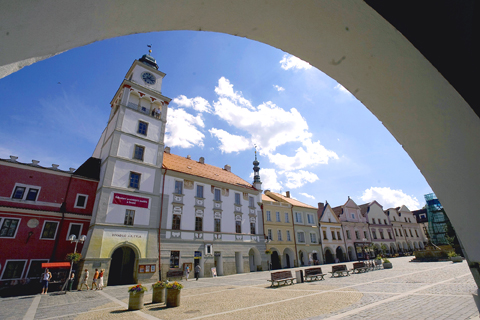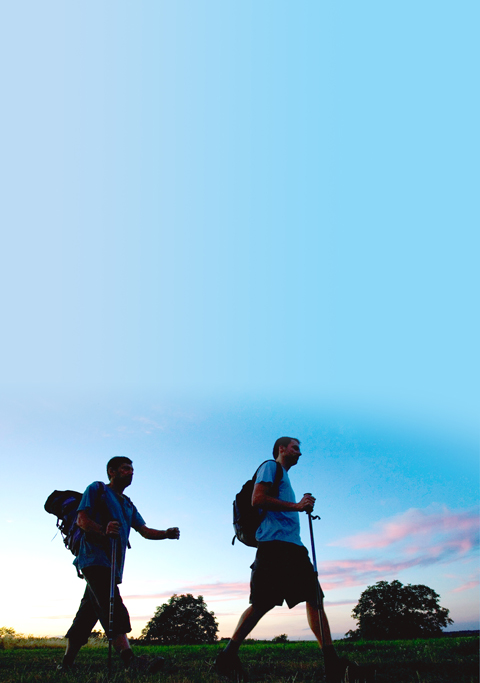The border between the Czech Republic and Austria was less than a kilometer away, when an old man mysteriously appeared in the middle of the leafy one-lane road. A generation ago, he might have been shot for being this close to the former buffer zone of the Iron Curtain.
“Dobry den,” I said, wishing him a “good day.” But he just stood there in frozen silence, a you’re-not-from-these-parts look on his face. So I soldiered on, merrily continuing on my scenic hike through the Bohemian woods.
During the Cold War, this slice of Central Europe was verboten to anyone but residents of a few ancient villages and the guards patrolling the frontier. The Czechoslovak government cleared the buffer zone of locals and populated it with card-carrying members of the Communist Party. That might explain why, two decades after the Berlin Wall fell, a haunted stillness hung over this coniferous landscape of low-rolling hills.

PHOTO: NY TIMES NEWS SERVICE
It is also a reason the network of hiking and biking trails in those hills of southern Bohemia remain among the Continent’s most pristine and untrammeled.
The Czechs, known for their prowess in making beer and playing hockey, are also a nation of prolific hikers. Etched throughout this Central European country are nearly 40,000km of color-coded hiking trails, stretching from Karlovy Vary in the northwest to Ostrava in the east. Much of it is maintained by the Czech Hiking Club, a private organization, dating back to 1889, that splashes painted trail markers across trees and installs signposts.
With so many trails to explore, how does a non-Czech hiker choose the right route? For my wife, Jessie, and I, the answer was simple. We would spend five days walking trails of the Czech Greenways, a network of old trading routes that were recently restored by the Friends of Czech Greenways, a nonprofit group based in Brooklyn, New York.

PHOTO: NY TIMES NEWS SERVICE
The network, also called the Prague-Vienna Greenways, is the brainchild of Lubomir Chmelar, a retired architect who splits his time between New York City and Mikulov, a small southeastern town near the Austrian border. He was inspired by the Hudson River Valley Greenway, a revitalization project in New York that has spurred recreation and culture along the riverfront from just north of New York City to Albany, the state capitol.
Chmelar assembled a team of landscape architects and Harvard MBAs and set off on foot to find the most scenic route between Prague and Vienna. The result is a 402km-long network of trails, zigzagging between the two European capitals past ruined castles, cute villages, dense forests and the once-forbidden Cold War border.
A few weeks before my hike, I met up with Chmelar, 73, hoping that he’d help me decide which section of the greenway I should hike. Chmelar, a tall and dapper man who spoke with an Oxford-educated accent, excitedly threw out numerous itineraries. Eventually, we settled on my jaunt: we’d start halfway between the two capitals, in the picturesque town of Cesky Krumlov, and head east and northeast about 129km to the medieval town of Slavonice, about a kilometer from the Austrian border. The hike offered a mix of gorgeous Baroque towns, varied terrain and a dose of history in a part of the country that tourists rarely see.
Chmelar offered a little history lesson himself. Under communism, he said, even hiking was politicized. “The government preferred keeping people in the pub,” he said, “not deep in the forest where they don’t know what they’re up to.”
We set out in mid-May, on a cold morning when the majestic castle of Cesky Krumlov cast a long shadow over the town’s quiet cobblestone streets. My wife and I slung on our medium-size backpacks, filled with two-days’ worth of clothes, bandages (for blisters) and several maps of south Bohemia. Then we boarded a bus.
Although we would cover most the trail by foot, the cheap and efficient Czech bus system also meant we could hop on buses to keep the daily hikes under 40km. The idea would be to hit the trail early in the morning, so we could arrive at our destination for a late lunch and spend the remainder of the day sightseeing.
The bus took us over the steep surrounding hills and deposited us 24km away in Kaplice, a tiny town at the foot of the Novohradske mountains. We found a red-and-white-striped trail marker in the town’s center that lead us up a dirt path. Within minutes, we were hiking through dense pine forests and skirting yellow-poppy-filled prairies, so bright and expansive that it almost gave me vertigo.
About five hours and 13km later, we entered Benesov nad Cernou, a village that was little more than a square with a yellow-and-white church at one end. That night, we celebrated our first day of hiking in one of the town’s two noisy pubs. We washed down plates of svickova (roasted tenderloin slathered in gravy and topped with a dollop of cream and cranberries) with pints of Budweiser (the Czech version) while mustached men chain-smoked and screamed at a televised soccer match.
The next couple of days took us through wildly diverse terrain that included two 792m-high mountains and an English-style park dotted with oak trees and empty fortresses. In Nove Hrady, a hilltop town with a leafy main square, we slept in a monastery once used to house guards who patrolled the border. We strode through sleepy villages where the only sound was the echo of a soccer ball, bouncing off a stone wall.
Fortunately, Trebon, where we spent our third night, was more dynamic. This town of nearly 9,000 people was the perfect rest stop after a trek of some 35km through swamps, pine forests and deer-filled prairies. The town has a small castle, an irregularly shaped square flanked by colorful Baroque apartment houses, a spa and a warren of winding lanes — all encircled by thick walls.
But we had not gone there to sightsee. Trebon is famous for the Bohemia Regent Brewery, which has been making its fabulously hoppy beer since 1379. After checking into our hotel — a quiet pension just outside the walls — we made our way to the brewery’s pub, where we sat on the terrace, chatting with a man named Jiri, who told us about his escape to France during the Cold War. As the sun set, we nursed pints of opaque, orange-hued beer, a special unfiltered brew sold only there, and toasted to getting halfway through our hike.
We spent the rest of the day exploring another of Trebon’s oddities. Just outside the town walls were artificial lakes teeming with carp. Some people call carp river scum; the good people of Trebon, however, call them dinner. We ended up at Supinka, a surprisingly chic restaurant that serves carp in just about every conceivable way: fried, pan-seared, and poached; sprinkled with paprika, marinated in soy sauce, drenched in chili or topped with garlic sauce.
For our final day, we took a bus from Jindrichuv Hradec to Nova Bystrice, about 24km from our finish line. A black dog trailed us out of Nova Bystrice until we reached the village of Klaster. About 8km later, we passed the imposing Landstejn castle, then hiked through dense fern-blanketed pine forest. I half expected to see a troll or a gnome. Instead, we came across igloo-like concrete bunkers, many of which were camouflaged with dirt and tree branches.
These bunkers, it turned out, were built from 1935 to 1938 to guard the Czechoslovak border against an invasion by Hitler. But during the Cold War, the bunkers served the opposite function: to prevent Czechoslovak citizens from escaping to the West. That might explain why the area felt spooky.
As we passed the final bunker, the Renaissance-era bell tower of Slavonice came into view. We trudged through a neighborhood of 19th-century houses and through one of Slavonice’s medieval stone gates.
The tiny town looked like it hadn’t changed in two centuries, with triangular-shaped piazzas lined with old Renaissance apartment buildings painted with colorful, comic-strip-like biblical scenes. Back in the 15th century, Slavonice was a common stopover on the Prague-to-Vienna trade route. Today, it’s become a magnet for artists and bohemians from Prague.
And, of course, it is also attracting visitors like me, looking for a cheap place to stay and a friendly pub in which to rest my feet and nurse a sudsy beer after an 128km Bohemian hike. We put down our backpacks and headed for the first bar we saw.
FINDING YOUR WAY

Wooden houses wedged between concrete, crumbling brick facades with roofs gaping to the sky, and tiled art deco buildings down narrow alleyways: Taichung Central District’s (中區) aging architecture reveals both the allure and reality of the old downtown. From Indigenous settlement to capital under Qing Dynasty rule through to Japanese colonization, Taichung’s Central District holds a long and layered history. The bygone beauty of its streets once earned it the nickname “Little Kyoto.” Since the late eighties, however, the shifting of economic and government centers westward signaled a gradual decline in the area’s evolving fortunes. With the regeneration of the once

Even by the standards of Ukraine’s International Legion, which comprises volunteers from over 55 countries, Han has an unusual backstory. Born in Taichung, he grew up in Costa Rica — then one of Taiwan’s diplomatic allies — where a relative worked for the embassy. After attending an American international high school in San Jose, Costa Rica’s capital, Han — who prefers to use only his given name for OPSEC (operations security) reasons — moved to the US in his teens. He attended Penn State University before returning to Taiwan to work in the semiconductor industry in Kaohsiung, where he

In February of this year the Taipei Times reported on the visit of Lienchiang County Commissioner Wang Chung-ming (王忠銘) of the Chinese Nationalist Party (KMT) and a delegation to a lantern festival in Fuzhou’s Mawei District in Fujian Province. “Today, Mawei and Matsu jointly marked the lantern festival,” Wang was quoted as saying, adding that both sides “being of one people,” is a cause for joy. Wang was passing around a common claim of officials of the People’s Republic of China (PRC) and the PRC’s allies and supporters in Taiwan — KMT and the Taiwan People’s Party — and elsewhere: Taiwan and

On May 2, Chinese Nationalist Party (KMT) Chairman Eric Chu (朱立倫), at a meeting in support of Taipei city councilors at party headquarters, compared President William Lai (賴清德) to Hitler. Chu claimed that unlike any other democracy worldwide in history, no other leader was rooting out opposing parties like Lai and the Democratic Progressive Party (DPP). That his statements are wildly inaccurate was not the point. It was a rallying cry, not a history lesson. This was intentional to provoke the international diplomatic community into a response, which was promptly provided. Both the German and Israeli offices issued statements on Facebook